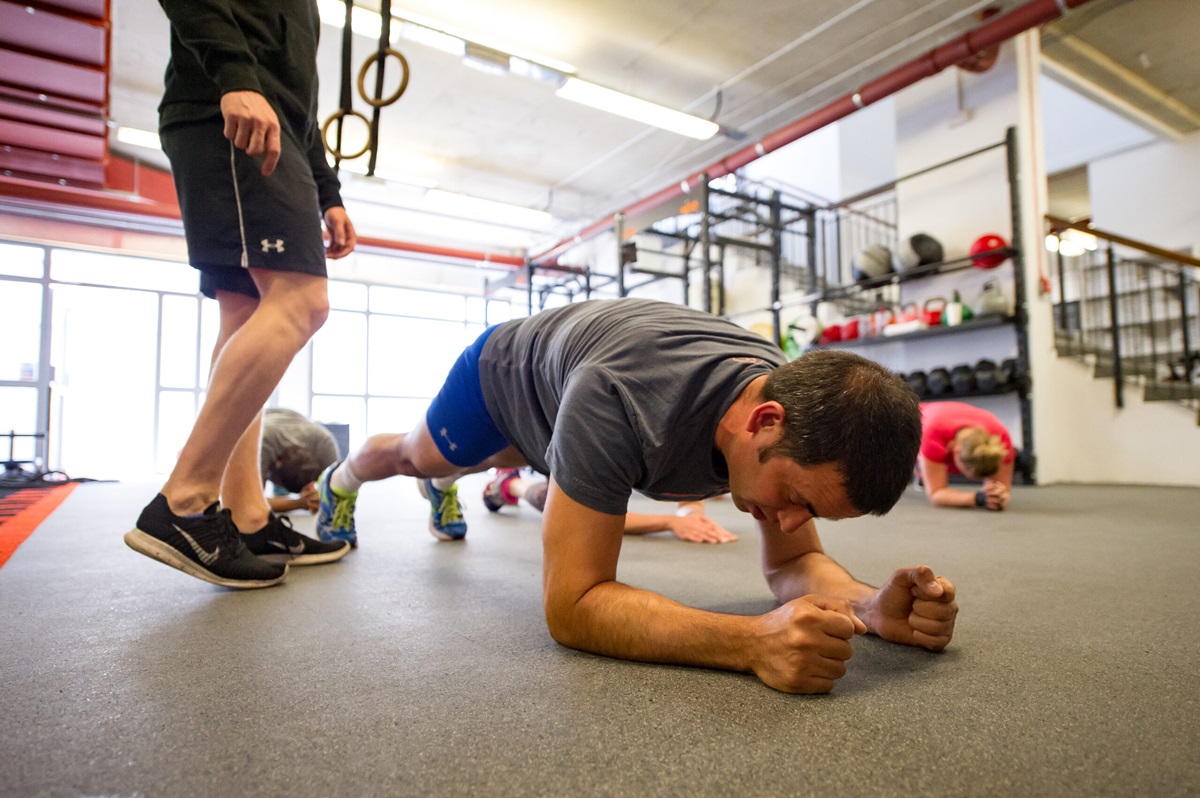Home>Misc>Featured>How Is Interval Training Different From HIIT


Featured
How Is Interval Training Different From HIIT
Modified: January 2, 2024
Discover the key differences between interval training and HIIT workouts in our featured article. Find out which training method best suits your fitness goals.
Introduction
Welcome to the world of interval training and HIIT – two popular workout techniques that have gained immense popularity in recent years. Whether you’re a fitness enthusiast looking to spice up your routine or a beginner looking for effective ways to get in shape, understanding the differences between interval training and HIIT can help you make informed decisions about your workouts.
Interval training and HIIT are both forms of cardiovascular exercise that involve alternating periods of intense activity with periods of rest or low activity. These training methods are known for their ability to maximize calorie burn, improve cardiovascular fitness, and increase overall endurance. However, despite their similarities, there are key differences that set them apart.
In this article, we will delve into the definitions of interval training and HIIT, explore the main differences between the two, and discuss the various benefits they offer. Additionally, we will provide tips on how to incorporate each technique into your fitness routine and highlight common mistakes to avoid. By the end of this article, you will have a clear understanding of which approach aligns best with your fitness goals and how to optimize your workouts for success.
Definition of Interval Training
Interval training is a workout method that involves alternating between periods of high-intensity exercise and periods of lower intensity or rest. This type of training is characterized by its structured and repetitive nature, where specific intervals of work and rest are followed.
The work intervals in interval training are typically performed at a higher intensity, where you push yourself to your maximum effort. This can include exercises such as sprinting, cycling at a fast pace, or performing high-intensity bodyweight exercises. The duration of the work intervals can vary depending on your fitness level and goals. Typically, they range from 30 seconds to several minutes.
After completing the work interval, a period of rest or lower intensity exercise follows. During this rest period, you allow your body to recover and prepare for the next work interval. This can involve walking, slow jogging, or performing exercises at a lower intensity. The duration of the rest intervals can also vary, but they are typically shorter than the work intervals.
Interval training is a versatile workout method that can be customized to fit your fitness level and preferences. You can choose the duration and intensity of the work intervals and rest periods based on your goals and capabilities.
One of the main benefits of interval training is its ability to increase your cardiovascular fitness and improve endurance. By pushing yourself to your maximum effort during the work intervals, you challenge your cardiovascular system and stimulate adaptations that lead to improved aerobic capacity.
Interval training is also an efficient way to burn calories and boost your metabolism. The intense bursts of exercise during the work intervals elevate your heart rate and increase calorie burn both during and after the workout. This effect, known as excess post-exercise oxygen consumption (EPOC), helps your body continue to burn calories at a higher rate even after you’ve finished exercising.
Definition of HIIT (High-Intensity Interval Training)
HIIT, or High-Intensity Interval Training, is a specific type of interval training that is characterized by short bursts of intense exercise followed by periods of active recovery. HIIT workouts are designed to maximize calorie burn and improve cardiovascular fitness in a shorter amount of time compared to traditional steady-state cardio.
The intensity of HIIT exercises is significantly higher than that of regular interval training. During the high-intensity intervals, you push yourself to your maximum effort, reaching around 80-95% of your maximum heart rate. This can include exercises such as burpees, squat jumps, or intense cardio exercises like sprints on a treadmill or cycling at maximum effort.
The high-intensity intervals are typically shorter in duration, ranging from 20 seconds to a few minutes. After the intense burst of exercise, a period of active recovery follows. During this recovery period, instead of completely resting, you engage in lower-intensity activities like light jogging, walking, or performing exercises at a slower pace. The duration of the recovery intervals is usually shorter than the work intervals.
One of the primary benefits of HIIT is its ability to maximize calorie burn during and after the workout. The intense bursts of exercise elevate your heart rate and deplete your energy stores, leading to a higher post-workout calorie burn. This effect is known as excess post-exercise oxygen consumption (EPOC), where your body continues to burn calories at an accelerated rate even after you’ve finished working out.
Another advantage of HIIT is its ability to improve cardiovascular fitness and endurance. The rapid changes in heart rate experienced during the high-intensity intervals push your cardiovascular system to adapt and become more efficient. Over time, this can lead to increased aerobic capacity and improved overall cardiovascular health.
Furthermore, HIIT workouts offer a time-efficient way to achieve your fitness goals. Since the workouts are intense and shorter in duration compared to traditional aerobic exercises, you can get a highly effective workout in just 20-30 minutes.
Key Differences Between Interval Training and HIIT
While both interval training and HIIT involve alternating periods of intense exercise with periods of rest or lower intensity, there are several key differences between the two techniques. These differences lie in the intensity, duration, and structure of the workouts.
Intensity: One of the main distinctions between interval training and HIIT is the level of intensity. HIIT workouts are generally performed at a higher intensity, requiring you to push yourself to your maximum effort. The high-intensity intervals in HIIT can reach 80-95% of your maximum heart rate. On the other hand, interval training workouts can vary in intensity and may not require you to reach your maximum effort.
Duration: Another difference lies in the duration of the intervals. In HIIT, the high-intensity intervals are typically shorter, ranging from 20 seconds to a few minutes. The active recovery periods are also shorter in comparison. In interval training, the durations of both the work intervals and rest intervals can vary depending on your fitness level and goals.
Structural Variations: The structure of interval training and HIIT workouts may also differ. Interval training often follows a fixed pattern where you perform a certain number of work intervals followed by rest intervals, with the repetition of this pattern throughout the workout. HIIT, on the other hand, may include variations in the length and intensity of the intervals within a single session.
Focus: The emphasis of interval training and HIIT can also vary. Interval training is often used to improve endurance, cardiovascular fitness, and calorie burn. It can be a suitable option for individuals looking to build a solid aerobic base. HIIT, on the other hand, is specifically designed to maximize calorie burn, boost metabolism, and improve cardiovascular fitness in a shorter period of time.
Flexibility: Interval training allows for more flexibility in terms of intensity and duration, making it adaptable to different fitness levels and goals. HIIT workouts, due to their higher intensity, may be more challenging for beginners or individuals with certain health conditions. It is important to listen to your body and start with manageable intensities when incorporating HIIT into your routine.
Ultimately, the choice between interval training and HIIT depends on your fitness goals, preferences, and current fitness level. It is recommended to consult with a fitness professional to determine which approach is best suited for you and to ensure proper technique and safety.
Benefits of Interval Training
Interval training offers a range of benefits that make it a popular choice among fitness enthusiasts. Whether you’re looking to improve your cardiovascular fitness, burn calories, or enhance your endurance, interval training can be a highly effective workout method. Here are some of the key benefits of interval training:
1. Improved Cardiovascular Fitness: Interval training challenges your cardiovascular system by alternating between intense exercise and rest periods. This type of training stimulates adaptations in your heart and lungs, leading to improved aerobic capacity and overall cardiovascular health.
2. Increased Calorie Burn: The high-intensity intervals in interval training elevate your heart rate and increase your metabolic rate. This results in a higher calorie burn during the workout and even after you’ve finished exercising. The “afterburn effect,” known as excess post-exercise oxygen consumption (EPOC), allows your body to continue burning calories at a higher rate for hours after your workout.
3. Time Efficiency: Interval training is a time-efficient workout method. Due to the intensity of the workout, you can achieve significant benefits in a shorter amount of time compared to steady-state cardio. This is especially advantageous for individuals with busy schedules who are looking to optimize their workout routine.
4. Versatility: Interval training can be adapted to suit various fitness levels and goals. You can adjust the duration and intensity of the work and rest intervals based on your needs and capabilities. This flexibility makes interval training accessible to beginners and allows for progression as you build strength and endurance.
5. Muscle Endurance: Interval training can improve your muscle endurance. The intense bursts of exercise engage and challenge your muscles, enhancing their ability to perform for longer periods of time. This can be particularly beneficial for athletes and individuals participating in sports that require prolonged periods of physical exertion.
6. Variety and Preventing Plateaus: Incorporating interval training into your routine helps break the monotony of traditional steady-state cardio workouts. The constant variation in intensity keeps your body challenged and prevents fitness plateaus. Plus, the wide range of exercises that can be included in interval training adds diversity and keeps your workouts engaging and enjoyable.
By incorporating interval training into your fitness routine, you can reap these benefits and experience a fun, effective, and efficient way to improve your overall fitness and well-being.
Benefits of HIIT
High-Intensity Interval Training (HIIT) offers a multitude of benefits that make it a popular choice for individuals looking to maximize their workouts and achieve their fitness goals. Whether you want to burn calories, improve cardiovascular health, or increase endurance, HIIT can provide significant advantages. Here are some key benefits of incorporating HIIT into your fitness routine:
1. Efficient Calorie Burn: HIIT workouts are highly effective for calorie burning. The intense bursts of exercise during the high-intensity intervals elevate your heart rate and trigger a metabolic response that leads to increased calorie burn. The afterburn effect, or Excess Post-Exercise Oxygen Consumption (EPOC), keeps your metabolism elevated even after your workout, allowing you to continue burning calories for hours.
2. Time Savings: HIIT workouts are known for their time efficiency. Due to the high intensity and shorter duration of the workouts, you can achieve the same or even greater fitness benefits compared to longer, steady-state cardio workouts. This makes HIIT an excellent option for those with a busy schedule or limited time to dedicate to exercise.
3. Improved Cardiovascular Health: HIIT is a powerful method for improving cardiovascular fitness. The intense intervals push your heart rate to higher levels, improving its strength and efficiency. Over time, this can result in better oxygen delivery to your muscles, increased lung capacity, and improved overall cardiovascular health.
4. Enhanced Fat Loss: HIIT workouts target stubborn body fat. The high-intensity intervals activate your body’s fat-burning mechanisms, helping you shed unwanted pounds and reduce body fat percentage. Additionally, the metabolic boost from HIIT can lead to long-term fat loss even after you’ve completed your workout.
5. Increased Endurance: HIIT workouts can significantly improve your endurance and stamina. The intense bursts of exercise followed by short recovery periods challenge your muscles and cardiovascular system, gradually increasing your capacity to sustain high-intensity efforts. This translates to improved performance during other workouts or athletic activities.
6. Variety and Adaptability: HIIT offers a wide range of exercises and variations that can be tailored to fit your preferences and fitness level. You can customize your workout by choosing different exercises, intervals lengths, and even incorporating equipment like dumbbells, resistance bands, or kettlebells. This versatility keeps your workouts exciting, prevents boredom, and allows for continuous progress and challenge.
7. Applicable to Different Fitness Levels: Despite its reputation for intensity, HIIT workouts can be modified to accommodate various fitness levels. Beginners can start with lower-intensity exercises or longer recovery periods, gradually building up their endurance and tolerance for higher intensity. Advanced individuals can incorporate more challenging exercises or shorten their recovery periods for an added challenge.
Incorporating HIIT into your fitness routine can provide these benefits and more. However, it’s essential to listen to your body, maintain proper form, and gradually increase the intensity and duration of your workouts to avoid overexertion and reduce the risk of injury.
How to Incorporate Interval Training into Your Fitness Routine
If you’re interested in incorporating interval training into your fitness routine, there are several approaches you can take. Whether you prefer cardio exercises, strength training, or a combination of both, interval training can be adapted to suit your needs. Here are some tips to help you get started:
1. Choose Your Activity: Decide on the type of exercise you want to perform during your interval training sessions. This can include running, cycling, jumping rope, bodyweight exercises, or a combination of different activities. Select an activity that you enjoy and feel comfortable performing at a high intensity.
2. Warm Up: Before diving into the high-intensity intervals, it’s crucial to warm up your body to prevent injuries. Spend 5-10 minutes performing light cardio exercises such as brisk walking, jogging, or cycling. This helps increase your heart rate gradually and prepare your muscles for the upcoming intensity.
3. Set Your Intervals: Determine the duration of your work intervals and rest intervals based on your fitness level and goals. Beginners might start with shorter work intervals (e.g., 30 seconds) and longer rest intervals (e.g., 1-2 minutes), while more advanced individuals can increase the intensity and decrease the rest time. Experiment with different interval lengths to find what works best for you.
4. Start with a Ratio: A common approach in interval training is to start with a 1:1 work-to-rest ratio. For example, perform a high-intensity exercise for 30 seconds, followed by 30 seconds of low-intensity exercise or rest. As you progress, you can adjust the ratio to challenge yourself further, such as a 2:1 or 3:1 work-to-rest ratio.
5. Gradually Increase Intensity: Begin with moderate intensity during your work intervals and gradually increase the level of effort over time. Push yourself to perform at your maximum effort during the high-intensity intervals while maintaining proper form and technique. Remember to listen to your body and avoid overexertion.
6. Mix It Up: Keep your interval training sessions interesting by incorporating a variety of exercises. You can alternate between cardio exercises like running or cycling and bodyweight exercises such as squats, lunges, or burpees. This not only keeps your workout engaging but also helps target different muscle groups and boost overall fitness.
7. Progression and Recovery: As you become more comfortable with interval training, gradually increase the duration or intensity of your work intervals and decrease the rest time. However, ensure you include sufficient recovery periods between high-intensity sessions to allow your body to rest and repair. Overtraining can lead to fatigue and increased risk of injuries.
Remember, interval training is intense, so it’s essential to listen to your body and adjust the intensity and duration of your workouts based on your fitness level. It’s recommended to consult with a fitness professional to ensure proper form and to design a program that aligns with your specific goals and abilities.
How to Incorporate HIIT into Your Fitness Routine
Adding High-Intensity Interval Training (HIIT) to your fitness routine can be an effective way to boost your workouts and achieve your fitness goals. Whether you’re new to HIIT or have previous experience, here are some tips to help you incorporate HIIT into your routine:
1. Choose Your Exercises: Select a variety of exercises that you enjoy and can perform at a high intensity. This can include bodyweight movements like burpees, mountain climbers, or squat jumps, as well as cardio exercises like sprints, jumping jacks, or stationary biking. The key is to choose exercises that engage multiple muscle groups and elevate your heart rate.
2. Time Your Intervals: Determine the duration of your high-intensity intervals and active recovery periods. A common HIIT protocol is to perform 20-30 seconds of intense exercise followed by 10-20 seconds of active recovery. Experiment with different interval lengths to find the right challenge for your fitness level.
3. Customize Your Ratios: Adjust the work-to-rest ratios based on your preferences and goals. Beginners may start with a 1:1 work-to-rest ratio, while more advanced individuals can increase the intensity by implementing a 2:1 or even a 3:1 work-to-rest ratio. Find a ratio that challenges you while still allowing for proper recovery.
4. Warm Up and Cool Down: Prioritize a warm-up and cool-down to prepare your body for the intense exercise and promote recovery. Spend 5-10 minutes performing dynamic stretches and light cardio exercises like jogging or jumping jacks to warm up your muscles and increase blood flow. After your HIIT session, allocate time for static stretching and gentle movements to cool down and help prevent muscle soreness.
5. Start with Short Sessions: If you’re new to HIIT, begin with shorter sessions. Aim for 10-15 minutes of HIIT workouts and gradually increase the duration as you build strength and endurance. Quality is more important than quantity, so focus on maintaining proper form and intensity during your intervals rather than trying to extend the session beyond your capability.
6. Incorporate HIIT Workouts Into Your Schedule: Dedicate specific days or times during the week for your HIIT workouts. Consistency is key, so find a schedule that works best for you and stick to it. HIIT can be demanding on your body, so space out your HIIT sessions with sufficient rest and recovery days in between.
7. Combine HIIT with Other Training Methods: HIIT can complement other training methods in your fitness routine. You can alternate HIIT workouts with strength training, cardiovascular workouts, or low-impact activities to create a well-rounded exercise program. This variety helps prevent boredom and allows for optimal muscle development and cardiovascular conditioning.
8. Listen to Your Body: Pay attention to your body’s signals and adjust the intensity or duration of your intervals as needed. HIIT is a high-intensity workout, so it’s crucial to find a balance between pushing yourself and avoiding overexertion. Rest when needed, modify exercises if necessary, and always prioritize proper form and technique.
Remember, HIIT is adaptable to different fitness levels. Start at a level that challenges you but is still manageable, and gradually progress as your fitness improves. If you’re unsure about designing a HIIT workout plan, consult with a fitness professional who can provide guidance and ensure you’re performing the exercises correctly.
Common Mistakes to Avoid in Interval Training
Interval training is a highly effective workout method, but like any fitness routine, it’s important to approach it with the right knowledge and technique. To ensure you get the most out of your interval training sessions and minimize the risk of injury, here are some common mistakes to avoid:
1. Skipping the Warm-up: Failing to warm up properly before your interval training session is a common mistake. Skipping the warm-up can increase the risk of muscle strains and other injuries. Take the time to perform dynamic stretches and light cardiovascular exercises to warm up your muscles, increase blood flow, and prepare your body for the intense workout ahead.
2. Overdoing It: Pushing yourself too hard and exceeding your physical capabilities can lead to overexertion and potential injuries. While it’s important to challenge yourself, listen to your body and gradually progress the intensity and duration of your intervals. Avoid jumping into high-intensity workouts without building a solid foundation of fitness first.
3. Neglecting Proper Form: Maintaining proper form during interval training exercises is crucial to prevent injuries and maximize the effectiveness of the workout. Improper form can put unnecessary stress on your joints and muscles, leading to strain or discomfort. Focus on maintaining good posture, engaging the correct muscles, and using controlled movements throughout each exercise.
4. Ignoring Rest and Recovery: Rest and recovery periods are essential for allowing your body to repair and adapt to the demands of interval training. Avoid the mistake of neglecting rest days between workouts or not including proper recovery periods during your intervals. Overtraining can lead to fatigue, decreased performance, and increased risk of injuries.
5. Lack of Progression: Plateauing can occur when you don’t increase the intensity or duration of your intervals over time. Your body adapts to the exercise stimulus, and to continue seeing improvements, you need to progressively challenge yourself. Gradually increase the intensity, shorten rest intervals, or incorporate more challenging exercises as you become stronger and more experienced.
6. Improper Breathing: Proper breathing technique is often overlooked during interval training. Holding your breath or breathing shallowly can hinder your performance and limit the amount of oxygenated blood reaching your muscles. Practice deep, rhythmic breathing, inhaling through your nose and exhaling through your mouth, to optimize oxygen delivery and enhance your stamina and endurance.
7. Lack of Variety: Doing the same interval training routine repeatedly can lead to boredom and diminished results. Keep your workouts exciting and challenging by incorporating a variety of exercises, interval lengths, and training modalities. This not only prevents monotony but also ensures you engage different muscle groups and maintain overall fitness improvements.
8. Neglecting Recovery Nutrition: After your interval training session, it’s important to replenish your body with proper nutrition. Many people make the mistake of neglecting post-workout nutrition, which can hinder muscle recovery and slow down progress. Aim to consume a balanced meal or snack containing protein and carbohydrates within an hour of completing your workout.
Avoiding these common mistakes will help you get the most out of your interval training sessions, minimize the risk of injury, and achieve optimal results. Always prioritize safety, listen to your body, and consult a fitness professional if you’re unsure of proper technique or workout design.
Common Mistakes to Avoid in HIIT
High-Intensity Interval Training (HIIT) can be a highly effective workout method, but it’s important to approach it with the right knowledge and technique to ensure safety and maximize results. To avoid common pitfalls and get the most out of your HIIT sessions, here are some mistakes to avoid:
1. Skipping the Warm-up: Neglecting to warm up properly before a HIIT workout is a common error. Skipping the warm-up can increase the risk of muscle strains or other injuries. Take the time to perform dynamic stretches and light cardio exercises to warm up your muscles, increase blood flow, and prepare your body for the intense exercise ahead.
2. Pushing Too Hard Too Soon: HIIT by nature is intense, but pushing yourself beyond your limits too quickly can lead to burnout or injury. Gradually increase the intensity and duration of your high-intensity intervals as your fitness level improves. Listen to your body’s signals and adjust the workout intensity to a level that is challenging but still manageable.
3. Neglecting Proper Form: Maintaining proper form during HIIT workouts is crucial for preventing injuries and getting the most out of your exercises. Poor form can compromise your technique and put unnecessary stress on your joints and muscles. Focus on maintaining good posture, engaging the correct muscles, and performing exercises with control and precision.
4. Overlooking Rest and Recovery: Recovery is just as important as the high-intensity intervals in a HIIT workout. Failing to include proper rest and recovery periods can lead to overtraining, fatigue, and decreased performance. Allow your body enough time to rest and recover between HIIT sessions, and ensure you incorporate active recovery periods or complete rest intervals during your workouts.
5. Not Progressing Over Time: Your body adapts to the stimulus of HIIT workouts, so it’s essential to progressively challenge yourself to continue seeing improvements. Gradually increase the intensity, duration, or number of intervals as your fitness level allows. Keep pushing your limits to avoid plateauing and maintain consistent progress.
6. Sacrificing Proper Breathing: Proper breathing technique is often overlooked during intense HIIT exercises. Holding your breath or breathing shallowly can limit oxygen delivery to your muscles and hinder your performance. Practice deep, controlled breaths, inhaling through your nose and exhaling through your mouth, to optimize oxygen intake and enhance your stamina and endurance.
7. Lack of Variety: Repeating the same HIIT routine over and over can lead to a plateau in progress and mental burnout. Avoid this by incorporating a variety of exercises, interval lengths, and training modalities into your workouts. Not only does variety keep your workouts engaging, but it also ensures you target different muscle groups and continue challenging your body.
8. Ignoring Proper Nutrition: Proper nutrition is crucial for fueling your body and aiding in recovery after HIIT workouts. Neglecting post-workout nutrition can compromise your results and hinder muscle recovery. Aim to consume a balanced meal or snack containing both carbohydrates and protein within an hour after your HIIT session to replenish glycogen stores and support muscle repair.
By avoiding these common mistakes, you can enhance the effectiveness and safety of your HIIT workouts. Always prioritize proper technique, listen to your body, and consult a fitness professional if you need guidance or have any concerns.
Conclusion
Interval training and High-Intensity Interval Training (HIIT) are powerful workout methods that offer numerous benefits for individuals looking to improve their fitness and achieve their goals. While both techniques involve alternating periods of intense exercise with rest or lower intensity, there are key differences between them that make each unique.
Interval training provides a versatile and customizable approach to fitness, allowing individuals to adjust the duration and intensity of their intervals based on their fitness level and goals. It improves cardiovascular fitness, increases calorie burn, and enhances endurance. Interval training is a great choice for individuals looking to build a solid aerobic base and enjoy a variety of exercises in their routines.
HIIT takes interval training to another level by incorporating shorter, high-intensity intervals with active recovery periods. It maximizes calorie burn, improves cardiovascular health, and increases endurance in a shorter amount of time. HIIT is ideal for those looking for a time-efficient workout that challenges the body and promotes fat loss.
Incorporating interval training and HIIT into your fitness routine can yield impressive results. Remember the importance of warming up, choosing appropriate exercises, maintaining proper form, and progressing gradually. Avoid common mistakes such as neglecting rest and recovery, pushing too hard too soon, and overlooking proper nutrition.
Ultimately, the choice between interval training and HIIT depends on your fitness goals, preferences, and current fitness level. It’s essential to listen to your body, work within your capability, and consult with a fitness professional if needed. By incorporating interval training or HIIT into your routine, you can make your workouts more effective, efficient, and enjoyable, helping you reach your desired fitness level.









